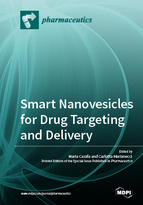Smart Nanovesicles for Drug Targeting and Delivery
A special issue of Pharmaceutics (ISSN 1999-4923).
Deadline for manuscript submissions: closed (30 November 2018) | Viewed by 72766
Special Issue Editors
Interests: phospholipid and non-phospholipid vesicles; pH-responsive vesicles; nanobubbles; nanoemulsions; brain delivery
Special Issues, Collections and Topics in MDPI journals
Interests: drug delivery; drug targeting; niosomes; liposomes; nanobubbles; nanoemulsions; brain targeting; theranostic
Special Issues, Collections and Topics in MDPI journals
Special Issue Information
Dear Colleagues,
Nanovesicles are highly-promising systems for the delivery and/or targeting of drugs, biomolecules and contrast agents. Despite the fact that initial studies in this area were performed on phospholipid vesicles, there is an ever-increasing interest in the use of other molecules to obtain smart vesicular carriers focusing on strategies for targeted delivery. These systems can be obtained using newly synthesized smart molecules, or by intelligent design of opportune carriers to achieve specific delivery to the site of action.
The drug/contrast agent-containing vesicles need to be directed to precise locations within the body to obtain desired magnitude and duration of the therapeutic or diagnostic effect. This spatial control in the delivery might open new avenues to modulate drug activity while avoiding side-effects and to optimize contrast agent properties while avoiding a broad distribution in the organism. However, delivering and targeting active substances into specific tissues and cells is still a challenge in designing novel therapeutic approaches against untreatable disorders, such as tumors and degenerative diseases.
The topics to be covered include, but not limited, to approaches employed in:
- Surfactant, polymeric and phospholipid vesicles
- Catanionic vesicles
- Exosomes
- Stimuli responsive carriers (e.g., pH or temperature sensitive vesicles)
- Vesicles for active and passive targeting
Prof. Maria Carafa
Dr. Carlotta Marianecci
Guest Editors
Manuscript Submission Information
Manuscripts should be submitted online at www.mdpi.com by registering and logging in to this website. Once you are registered, click here to go to the submission form. Manuscripts can be submitted until the deadline. All submissions that pass pre-check are peer-reviewed. Accepted papers will be published continuously in the journal (as soon as accepted) and will be listed together on the special issue website. Research articles, review articles as well as short communications are invited. For planned papers, a title and short abstract (about 100 words) can be sent to the Editorial Office for announcement on this website.
Submitted manuscripts should not have been published previously, nor be under consideration for publication elsewhere (except conference proceedings papers). All manuscripts are thoroughly refereed through a single-blind peer-review process. A guide for authors and other relevant information for submission of manuscripts is available on the Instructions for Authors page. Pharmaceutics is an international peer-reviewed open access monthly journal published by MDPI.
Please visit the Instructions for Authors page before submitting a manuscript. The Article Processing Charge (APC) for publication in this open access journal is 2900 CHF (Swiss Francs). Submitted papers should be well formatted and use good English. Authors may use MDPI's English editing service prior to publication or during author revisions.
Keywords
- Liposomes
- Niosomes
- Polymerosomes
- Drug delivery
- Drug targeting
- pH-sensitive
- Temperature-sensitive
- Theranostic








